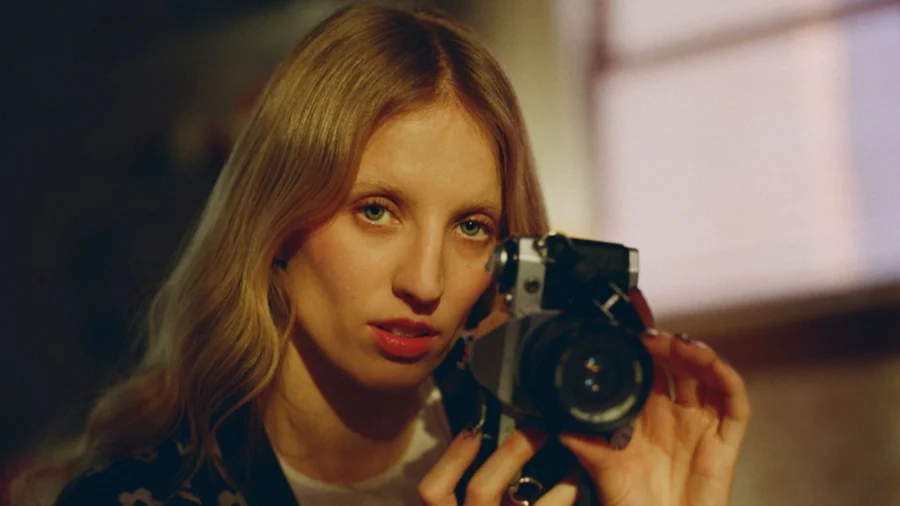Petra Collins, a Canadian artist, director, photographer, and actress born on December 21, 1992, rose to prominence in the early 2010s with her distinctive visual style that has significantly influenced contemporary culture. Her impact is so widespread that it’s difficult to imagine a show like Euphoria or the musical aesthetic of Olivia Rodrigo without acknowledging her foundational work. This has led to her being dubbed an “it girl” by figures like photographer Ryan McGinley and publications such as Vanity Fair and The New Yorker. Collins is a versatile creative who works across fine art, fashion, film, and music. Her fine art has been shown internationally in cities like Toronto, Hong Kong, and New York. She also creates fashion editorials for magazines like Vogue and Elle, and directs campaigns for brands like Gucci and Adidas.
At the heart of Collins’s art is a blend of a feminine, dreamlike aesthetic and an honest exploration of complex themes such as identity, vulnerability, sexuality, and the digital age. Her work is often described as intimate, surreal, and nostalgic, while also feeling youthful. Collins is known for bridging the gap between mainstream accessibility and deeper artistic inquiry. Her “addictive” style is emulated widely, and is seen in mainstream media like Euphoria and in the visual identity of Olivia Rodrigo. Despite this popular appeal, her images also explore “the nuances of femininity, identity, and vulnerability” and issues facing a generation shaped by social media. Her talent for fictionalizing “growing pains without losing the grit” demonstrates her ability to appeal to both commercial and critical audiences. The phrase “Petra Collins” has become “shorthand for a distinctive aesthetic,” which, while a testament to her influence, also risks oversimplification.
Formative Years and the Emergence of a Vision
Collins’s artistic journey began at age 15 in Toronto. She faced a challenging adolescence, including difficulties at home and failing her senior year. A key moment came when she transferred to an alternative school, where an art teacher helped her begin publishing her work. Collins has stated that art, especially photography, was her “way of communicating, and surviving”. Her dyslexia made reading and writing difficult, further cementing art as her main form of expression. These personal experiences are key to understanding her “dreamlike” and “whimsical” aesthetic, which she has said is a way to create “a world that I wish was accepted in, or that I wish that I lived in”. This escapist element directly explains her recurring theme of “pre-emptive nostalgia” for a “teenage life that I didn’t have”.
Early in her career, Collins was mentored by photographers Richard Kern and Ryan McGinley. At age 17 or 18, she created “The Ardorous,” a website for emerging female artists, aiming to challenge how women were portrayed. Her collaboration with Rookie magazine, founded by Tavi Gevinson, was a pivotal moment, providing her with creative freedom and regular assignments that helped her rapid ascent. This early focus on creating her own platforms and supporting other women foreshadowed her later work on the theme of “sisterhood”.
In 2014, Collins had her first solo exhibition, “Discharge,” which explored “the realities of youth”. Around the same time, her Instagram account was removed after she posted a photo of herself in a bikini without waxing. This incident became a pivotal public event, transforming her into a “feminist icon” and an advocate for “natural beauty”. This experience showed how digital spaces can become “battlegrounds for artistic freedom and feminist advocacy”.
Deconstructing the Collins Aesthetic
Collins’s work is recognizable for its “feminine, dreamlike feel”. Her signature style uses soft focus and hazy, colored lighting, often with pastel and neon hues. She exclusively shoots with 35mm film and does not retouch her images, giving her work a “raw feel”. This choice is a deliberate artistic statement, challenging the “digital paradox” of online perfection. Collins aims to capture “what it is like to be human” and the “unsexy parts of womanhood”. She creates a “safe environment for authentic expression,” often allowing subjects to “guide where the camera goes”. However, some critics suggest that her early work’s “raw authenticity” was “highly constructed,” pointing to the careful use of props, makeup, and lighting. This suggests a tension where authenticity is not just captured, but also performed and curated.
Her aesthetic has evolved from the “sunny, pink” hues of her early work to a “harder edge” with sharper focus and harsher lighting. In her newer work, she experiments with “transformation, objectification, and surrealism”. Her collaboration with Alexa Demie on Fairy Tales exemplifies this shift, reimagining classic stories with an “erotic lens” and “monstrous prosthetics”. This evolution can be seen as a response to the widespread imitation and commercialization of her early style. Following the Euphoria dispute, Collins felt “compelled to change her style,” a process she described as an “exorcism”.
The Female Gaze and its Feminist Interrogations
Collins’s work is often seen as a key example of the “female gaze,” which contrasts with the historical “male gaze” and aims to challenge traditional portrayals of women in media. Her photos often depict women in relaxed poses with “inherent empathy”. However, some critics have argued that her work can be an “oversaturated neoliberal aesthetic” or “aesthetic feminism” that prioritizes visual appeal over political depth.
The 2013 Instagram censorship incident became a defining moment. After her photo of an unwaxed bikini line was removed, she publicly criticized the “misogyny which informs media depictions of women’s bodies”. She framed her act as one of defiance. This event transformed a personal act into a public debate, highlighting how digital platforms can enforce traditional, misogynistic beauty standards.
Collins’s work has also faced criticism for being associated with “white feminism” and for lacking diverse representation in projects like her curated book, Babe. Critics suggest her work may reduce feminism to a “branded aesthetic”. Collins has acknowledged the complexities of feminist discourse and defines feminism as being about “equality”. Her ability to apply her “infectious feminine aesthetic” to both fine art and advertising raises questions about whether her message is diminished by commercial integration.
Expanding Horizons: Directing, Collaborations, and Mainstream Influence
Collins has become a prolific director of music videos for artists like Carly Rae Jepsen, Lil Yachty, Selena Gomez, and Cardi B. She has a notable collaboration with Olivia Rodrigo, directing videos for songs like “Good 4 U,” “Brutal,” and “Vampire”. Her video for “Good 4 U” has over 500 million views. This transition from still photography to directing is a natural evolution of her visual storytelling. Her signature aesthetic, with its dreamlike quality, colored lights, and focus on emotions, translates directly to her film work, creating a cohesive artistic universe.
In the fashion world, Collins is both a creative director and a model. She has been a “face” for Gucci and Calvin Klein and launched her own clothing line, “I’m Sorry by Petra Collins”. Her own persona and aesthetic have become marketable brands. She sees her branded work as an “opportunity for serious feminist discussion”.
A major point of controversy in her career is the aesthetic of HBO’s Euphoria. Collins claims that the show’s creator, Sam Levinson, based the series’ visual style on her work after she was dropped from the project at the last minute. She expressed being “shocked” to see her creative vision used without her permission or attribution. This incident became a case study in artistic ownership and intellectual property. Collins felt “compelled to change her style” after the show became mainstream, a process she described as an “exorcism”.
Collins’s work is widely credited with defining the “ultimate Gen Z look,” influencing a large amount of millennial and Gen Z media. Her ability to “crack the code” for younger audiences comes from her skill in integrating nostalgia without oversimplifying her art. Her early work resonated with her peers because it authentically reflected their experiences, leading to its widespread popularization and imitation.
Artistic Philosophy and Future Directions
A core part of Collins’s philosophy is collaboration and empathy. She focuses on creating a “safe space” for her subjects and encourages them to “guide where the camera goes”. She views her creative process as a “beautifully charged exchange of collective energy”. This collaborative approach challenges traditional power dynamics in photography and aligns with her feminist agenda.
Collins considers photography her main form of expression, describing it as a “secret potion or formula”. Her work is deeply autobiographical and often reflects her “nostalgia not really being for the past, but being for a sort of life that I never had”. This “pre-emptive nostalgia” is a powerful tool she uses to create an idealized, yet raw, version of girlhood, which resonates with her audience by addressing universal longings.
Collins continues to push her artistic boundaries by experimenting with surrealism and transformation. Her upcoming projects include a narrative feature film and a shift toward more documentary work. She has said she finds it “more interesting when it’s not about me,” indicating a maturing perspective. Her “archival impulse” means her work is a continuous, evolving autobiography, where past pieces inform future ones.









